#there's a species of bird called a swallow
Explore tagged Tumblr posts
Text


#HMMM#no thots head empty#thoughts....sorry#Rick Grimes#*#rg#The Ones Who Live#sorry i missed sinday with this one#let's sin on Monday#tag yourself i'm below the frame#i used to famously find these shots in the OG series#pretty sure i made a gifset#bout to invest in those kneeling pads people who garden a lot use#excuse me but The Nose™#i have an interview tomorrow for a promotion let me have my trash ok#you look great in red babe#there's a species of bird called a swallow#that's me#*SIRENS WAILING* *GLASS BREAKING* *CAR HORNS* *AWHOOOGA* *DOGS BARKING*#*me on my lawn apologizing to CBS News while their helicopter circles overhead*
418 notes
·
View notes
Text
*Propaganda, fun facts, and owl pics under the cut
BARN OWL:

Last year's winner and our current reigning champion, the Barn Owl is back to defend their title! What makes the Barn Owl so popular? Their haunting face? Their screeching cries? Their vast range - nesting on every continent save Antarctica, vastly increasing their chance of being your local owl? Only you can say! And only you can secure the Barn Owl's victory for another year!
PYGMY OWL:

Meet the pygmy, an owl species so small that they are better called owlets! Don't underestimate these hunters, they're locked in a standing war with the songbirds - the owls swallowing the songbirds up and the songbirds retaliating by mobbing the owls in large flocks.
SNOWY OWL:

Known by many names: the polar owl, white owl, and Arctic owl among them, this is the largest North American owl by weight. Most snowy owls are barred with dark brown markings (like the one pictured here). If you see a pure white owl, it's a sure sign you've found a mature male.
EURASIAN EAGLE OWL:

Swooping in to riotous demand, behold the Eurasian Eagle Owl!
To all those mortally offended by the accidental exclusion of the Eurasian Eagle Owl last year, please accept this offering, of a link to Episode 100 of the very excellent podcast Beyond Blathers, bringing you 48 delightful minutes of Eurasian Eagle Owl facts and stories:
SAW-WHET OWL:

The most common owl in North American forests, the saw-whet owl calls through the evening skies with a high-pitched call like a saw being sharpened on a whet stone - hence the name.
SPECTACLED OWL:

The smart-looking Spectacled Owl makes its home in mature rainforest, though they have been known to venture into the desert for food. You'll know these owls by sight, thanks to their distinctive mask, and by sound, making a vibrating call like someone shaking a thin sheet of metal.
SCREECH OWL:

As the name suggests, you'll hear these owls before you see them, and you might think you're being haunted if you do! You might also be able to track them by their owl pellets - regurgitated packets of undigestable bones, fur, and feathers - littered around their nesting sites.
BARRED OWL:

You'll know Barred Owls when you hear them, calling "Who cooks for you? Who? Who? Who cooks for you?" through the dark of night. Compared to other owls, Barred Owls don't migrate. Fossils of this bird dating back 11,000 years have been found in Ontario
GREAT HORNED OWL:

Also called a tiger owl, a winged tiger, or a tiger of the air, these birds are fierce predators, capable of besting other raptors - including the barred owl. They are so strong, that it takes 28lbs of force to open their claws.
BURROWING OWL:

As the name suggests, these owls prefer nesting in the abandoned burrows of other underground-dwelling animals to roosting in the trees! though their nests may be pre-owned, these owls have been known to decorate with bottle caps and bits of foil or paper. By the same grounded preference, you're more likely to spot one running after its prey than flying, making good use of their long legs.
LONG-EARED OWL:

With a permanent expression of someone who just caught got doing something they're not supposed to, these owls are indeed sneaks, opting to claim nests built by others rather than constructing their own. But for all their sneaky ways, Long Eared Owls are among the friendliest, roosting in groups of up to 150 members.
BLACKISTON'S FISH OWL:

Standing at 70cm tall, the Blakiston's Fish Owl reigns in Northeast Asia as the largest living owl on earth. True to their name, they eat mostly fish and have no trouble diving from the skies in pursuit of a trout, pike, salmon.
#Spotify#superb owl#Superbowl#Superb Owl Competition#Superb Owl Competition 2025#polls#tumblr polls#owl#owls#superbowl 2025#wwdits#fun polls#poll
687 notes
·
View notes
Note
Here's my lazy girl. Could I pretty please get some more Kup crumbs? Love that old man. 🫣

Aww! Cute!

Don’t You Pt 6
Kup x Reader
• “Breathe, kid,” Kup growls under his breath, a hand reaching up to cup you against his neck where you’re perched on him. But you can’t tear your eyes from the giant, not-birds roosting in the trees. Heads tipping as your little group passes underneath and those glossy, insectile eyes focus on you.
• Feels you shudder and press yourself tighter against him, the way your heart is racing putting him on alert. He’s seen those things before, but they’re no threat. At least, not to bots. You, though? He’s aware that if he lets you down, one of those things would dive and have you before he could stop it. Swallow you alive the way he’s seen them do little animals. You’re too fragging tiny. “I hate this planet,” you mutter against him as one of the ugly things shuffles along a branch, making a clacking noise as it stares at you.
• “Frag off,” he snarls, drawing his weapon and firing a warning shot that sends the birds flapping and hopping away. But they don’t leave, staring at you with hungry, beady eyes. Shivering, you press your face into Kup’s neck. Hearing the bot rumbling softly as one of the younger bots laughs. ‘Maybe we should use the human for bait,’ someone jokes and your skin crawls as Kup glares at the offender.
• “Looks like we have a volunteer,” Kup calls out, holstering his weapon and pointing his cygar at the youngster who’d suggested you be bait for their target practice. “We’re here to help with Cybertron’s image. Our war ain’t made us many friends,” he adds. Which is why they’re out here dealing with a nasty, invasive species that was intentionally released here. And that happens to enjoy eating the native organics who aren’t equipped to deal with the things. “Now march your aft over there and see if you can’t scare us up some crawlers.”
• Crawlers? Watching the young bot shoot you a look like it’s your fault he got singled out, the others begin drawing their weapons as he jogs off into the trees. And Kup keeps his hand against you as he chews on his cygar and surveys the others. Not bothering with his weapon, yet. From the direction the bot had gone, there’s a screaming roar that lifts the fine hair at your nape. Staring as something somewhat like a giant millipede with an elongated snout full of teeth whips out of the trees, the thing big even compared to the bots as it screams and slings its bulk at the nearest bot, coiling about him as the others open fire. Dimly aware of Kup swearing when you start screaming as another one launches itself in a tangle of slavering jaws and long limbs at Springer. Because you really hate this freaking planet.
Previous
Next
205 notes
·
View notes
Text
Round 3 - Reptilia - Sphenisciformes

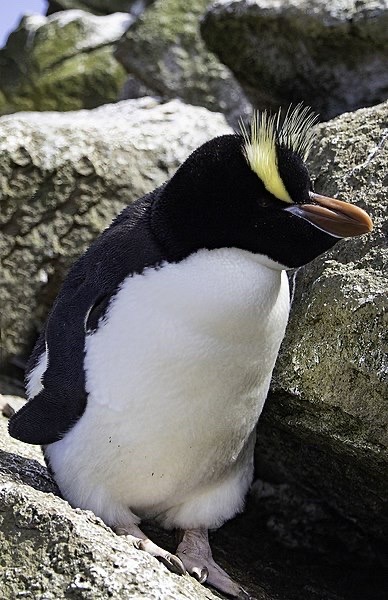

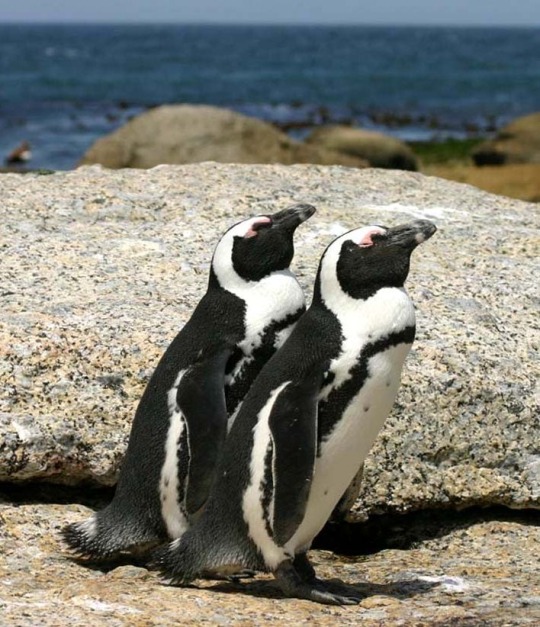
(Sources - 1, 2, 3, 4)
Our next order of birds are the Sphenisciformes, which contain one family, Spheniscidae, commonly called “penguins”.
Penguins are one of the most aquatic birds, highly adapted for life at sea. About half of their life is spent on land, while the other half is spent in the ocean. They are flightless, with wings modified into flippers for swimming. Their feathers are very dense, which help to both insulate the birds in cold water and trap a layer of air to ensure buoyancy. They can drink salt water because their supraorbital gland filters excess salt from the bloodstream, which is then excreted in a concentrated fluid from their nasal passages. On land, penguins either waddle on their feet or slide on their bellies across the snow while using their feet to propel and steer themselves. They also jump with both feet together if they want to move more quickly or cross steep or rocky terrain. Most penguins feed on krill, fish, squid, and other forms of sea life which they catch and swallow whole while swimming, using a spiny tongue and powerful jaws to grip their slippery prey. They live almost exclusively in the Southern Hemisphere; only one species, the Galápagos Penguin (Spheniscus mendiculus), is found north of the Equator. Larger penguins generally inhabit colder regions, while smaller penguins inhabit regions with temperate or tropical climates.
Penguins mostly breed in large colonies, the exceptions being the Yellow-eyed Penguin (Megadyptes antipodes) and Fiordland Penguin (Eudyptes pachyrhynchus). Penguin colonies may range in size from as few as 100 to as many as several hundred thousand, depending on species. Penguins form monogamous pairs for a breeding season, though the rate the same pair recouples the next year varies. Penguins lay one to two eggs in a clutch. Both parents share incubation duties, with the exception of the Emperor Penguin (Aptenodytes forsteri) (image 1), where the male does it all. Incubation shifts can last days and even weeks as one member of the pair feeds at sea. Penguin eggs are smaller than any other bird species when compared proportionally to the weight of the parent birds, but the shell is thick and the yolk is large. Some yolk may remain when the chick hatches, helping to sustain the chick if their parent is delayed in returning with food.
Penguins evolved in the Early Paleocene, around 62 million years ago. There is molecular evidence of an even earlier origin, in the Late Cretaceous.

Propaganda under the cut:
Penguins are named after the Great Auk (Pinguinus impennis), a now extinct, flightless shorebird. “Penguin” was the Spanish, Portuguese, and French name for the species. When European explorers saw what are today known as penguins in the Southern Hemisphere, they noticed their similar appearance to the Great Auk of the Northern Hemisphere and named them after this bird, although they are not closely related.
A group of penguins on land is called a “waddle”, and a group of penguins in the water is a “raft”.
The largest living penguin is the Emperor Penguin (Aptenodytes forsteri) (image 1). On average, adult Emperor Penguins are about 1.1 m (3 ft 7 in) tall and weigh 35 kg (77 lb).
Emperor Penguins are the world's deepest-diving birds. They can dive to depths of approximately 550 meters (1,804 feet) while searching for food.
The Emperor Penguin is able to control blood flow to their extremities, reducing the amount of blood that gets cold, but still keeping the extremities from freezing. In the extreme cold of the Antarctic winter, female Emperor Penguins are at sea fishing for food, leaving the males to brave the weather. Males often huddle together to keep warm and rotate positions to make sure that each penguin gets a turn in the centre of the heat pack.
When Emperor Penguin mothers lose a chick, they sometimes attempt to "steal" another mother's chick, usually unsuccessfully as other females in the vicinity assist the defending mother in keeping her chick.
The smallest penguin species is the Little Blue Penguin (Eudyptula minor) (image 3), also known as the Fairy Penguin, which stands around 30–33 cm (12–13 in) tall and weighs 1.2–1.3 kg (2.6–2.9 lb).
Some prehistoric penguin species were as large as humans, with the largest known being Kumimanu fordycei, which reached an estimated weight of 148–159.7 kg (326.3-352 lbs).
Gentoo Penguins (Pygoscelis papua) are the fastest underwater birds in the world. They are capable of reaching speeds up to 36 km (22.4 miles) per hour while searching for food or escaping from predators. They are also able to dive to depths of 170–200 meters (558-656 feet).
Around one in 50,000 penguins (of most species) are born with brown rather than black plumage. These are called isabelline penguins. Isabellinism is different from albinism. Isabelline penguins tend to live shorter lives than normal penguins as they are not well-camouflaged in the ocean, and are often passed over as mates.
Domestic Dogs preyed upon penguins while they were allowed in Antarctica during the age of early human exploration as sled dogs, but dogs have long since been banned from Antarctica.
Penguins had a popularity boom in the early 2000s, retaining a decade long chokehold on the media. There was rarely a year without a penguin-related movie in theaters, ranging from the animated jukebox musical “Happy Feet”, to the animated mockumentary “Surf’s Up”, to the brutally real documentary “March of the Penguins.”
The children’s book “And Tango Makes Three”, is an adaptation of the true story of a homosexual pair of Chinstrap Penguins (Pygoscelis antarcticus) at the Central Park Zoo. The male penguins were given an egg to hatch after they were observed showing courtship behavior and trying to incubate a rock. The practice of giving an egg to homosexual penguin (and other bird) pairs has been repeated in other zoos. Tango, their surrogate daughter, went on to form a relationship with a female penguin. “And Tango Makes Three” is one of the most banned books in America.
Penguins of many species have been impacted by oil spills across the Southern Hemisphere, but none so much as the critically endangered African Penguin (Spheniscus demersus) (image 4). Many oil spills have hit the African Penguin breeding colonies, but the most famous was on June 23, 2000, when the iron ore tanker MV Treasure sank between Robben Island and Dassen Island, South Africa. It released 400–1,000 tonnes of fuel oil, causing an unprecedented coastal bird crisis and oiling 19,000 adult penguins at the height of the best breeding season on record for this then vulnerable species. The oiled birds were brought to an abandoned train repair warehouse in Cape Town to be cared for. An additional 19,500 un-oiled penguins were removed from Dassen Island and other areas before they could become oiled and were released about 800 kilometres east of Cape Town. This gave workers enough time to clean up the oiled waters and shores before the birds could complete their long swim home (which took the penguins between one and three weeks). Tens of thousands of volunteers from around the world helped with the rescue and rehabilitation process, which was overseen by the International Fund for Animal Welfare (IFAW) and the South African Foundation for the Conservation of Coastal Birds (SANCCOB) and took more than three months to complete. This was the largest animal rescue event in history. More than 91% of the penguins were successfully rehabilitated and released: an amazing feat that could not have been accomplished without such a tremendous international response. The wild penguins are unfortunately still under threat from oil spills, as well as competition with fisheries. They were listed as critically endangered in 2024, with the remaining mature individuals numbering around 19,800 birds in a declining population. However, thanks to the tremendous rehab effort, it was discovered that African Penguins did very well in captivity, and a collaborative breeding program exists to ensure an assurance population.
African Penguins are not even the rarest penguins in the world. The endangered Yellow-eyed Penguin (Megadyptes antipodes) has experienced a significant decline over the past 20 years, with a remaining population of 2,528–3,480, owing to disease, invasive predators, and habitat loss. The endangered Galápagos Penguin (Spheniscus mendiculus) is particularly vulnerable due to its only native habitat being the Galápagos Islands. They have a decreasing population of around 1,200, owing to climate change and plastic waste pollution. Unfortunately, neither of these species has fared well in captivity, so no assurance population exists. They are all we have.
94 notes
·
View notes
Note
I have a friend who likes to see pictures of bright coloured birds when they are sad and your blog is the first place I go when I need to find coloured bird pics to make them less sad thank you for your service I hope you see many birds irl and have some of your favourite food to eat
Hey there, thank you.
I'm glad the birds help improve their mood.
I'm going out to Utah (Arches and Canyonlands) in a couple of weeks, and here are a few birds I'm hoping to see...

Western Tanager (Piranga ludoviciana), male, family Cardinalidae, southern Arizona, USA
Though it is called a tanager, this species is actually in the cardinal family.
photograph by jc_wings

Violet-green Swallow (Tachycineta thalassina), family Hirundinidae, order Passeriformes, Idaho, USA
photograph by Darren Clark
278 notes
·
View notes
Text
Wet Beast Wednesday: pelican
I'm trying something new for this week's WBW post. So far the only birds I've covered are the heavily aquatic penguins, but this time I'm going to cover a more conventional seabird. Let me know if you think these beasts aren't wet enough. For my first seabird I picked the Pelican.

(Image: a great white pelican (Pelecanus onocrotalus) in flight. It is a very large, white bird with black wingtips. It has a long neck that is coiled up and a long, skinny, yellow bill that is almost half as long as the body. The lower bill is leathery in texture. End ID)
Pelicans are eight species of the genus Pelecanus, the only extant member of the family Pelecanidae. While they were historically thought to be related to frigatebirds, cormorants, and boobies, they have recently been found to be closer to ibises, herons, and the shoebill stork (not actually a stork). Pelicans are among the largest and heaviest of flying birds, with the largest species, the Dalmatian pelican (Pelecanus crispus) reaching a wingspan up to 3.2 meters (10.5 ft) and an average weight of 11 kg (24 lbs). Easily the most famous feature of pelicans are their bills. The upper bill is very long and skinny, with a hook at the end. The lower bill is different from most birds. It is dominated by a pouch made of gular skin (gular skin connects the lower bill with the rest of the body) and structure is provided by two thin and flexible structures called rami. In other birds, the rami are hard and only part of the lower bill. This allows the pelican's lower bill to extend into a large pouch. In addition to its use in feeding, the throat pouch is also used for temperature regulation. By extending the pouch and shaking it in the air, the pelican can vent heat and lower its temperature. Internally, pelicans have a network of air sacs underneath the skin of their throat, breast, and underside of the wings. It is normal for birds to have air sacs connected to their respiratory system, but these specific sacs are found only in pelicans. The sacs can be inflated to provide buoyancy and possibly reduce impacts when diving into the water, as well as to shape the body for more aerodynamic and heat-conserving forms. As with most other seabirds, pelicans have a gland on the rear of the body that secretes a waterproof oil. Pelicans will preen to rub this oil onto their feathers to make them waterproof.

(Image: a Dalmatian pelican sitting in the water with its neck extended and mouth open at nearly a 90 degree angle. The lower bill is fully opened, showing off the large pouch-like appearance. Its body is white, with a reddish pouch. There is a tuft of feathers on the head. End ID)
Pelicans are found on all continents except Antarctica. They need to live near large bodies of water and are found primarily in coastal areas, though they will also follow rivers inland and live near lakes. Large rivers, such as the Mississippi, let pelicans establish populations very far inland. Pelicans can adapt to a wide range of water salinity, from fresh water to hypersaline lakes like the Great Salt Lake. Pelicans spend a lot of their time in water, where their air sacs allow them to float with only a small portion of the body actually preserved. Webbed feet and strong legs make them very efficient swimmers. Pelicans mostly hunt from the air. Their powerful vision allows them to see fish below the surface of the water. When prey is spotted, the pelican will fold its wings and dive into the water. The expandable pouch can scoop up fish and trap them as water is forced out. Prey is swallowed whole. Larger prey may need to be picked up in the beak and tossed into the air, where the pelican can catch it and direct it head-first down the throat. Fish make up the majority of the pelican diet, but they are opportunistic predators that will take amphibians, reptiles, small mammals, crustaceans, and other birds. Pelicans are also opportunistic scavengers and are a common sight at certain landfills.
Pelicans are typically split into two groups based on color and nesting behavior: the ground-nesting white pelicans (consisting of the Australian, American white, dalmatian, and great white pelicans) and the brown pelicans, who have darker plumage and nest in trees or on rocks (consisting of the pink-back, spot-billed, brown, and Peruvian pelicans). Nesting only happens during mating season. During mating season, pelicans will become more colorful. In addition, the American white pelican (Pelecanus erythrorhynchos) grows a distinctive sail-shaped knob on the upper bill that is shed after mating season. Ground-nesting and tree-nesting pelicans have distinct mate-attraction behaviors. Ground-dwellers will form groups of males that chase females while displaying with their wings and bills and will persist until the female picks a mate. Tree-dwelling males simply sit in the branches and display until a female comes to them. Once a pair has formed, they will stay monogamous for the season, then go their separate ways once the chicks have fledged.

(Image: an American white pelican in mating season. It is white and the upper bill has a distinctive round and flat knob growing near the tip. End ID)
Nests are built in communal areas constricted in size by food availability, but which can occasionally reach over a thousands individuals. The mother and father will take turns caring for the eggs and chicks while the other is looking for food. Eggs usually hatch within 36 days and the typical clutch size is 2 or 3 eggs, but sometimes up to 6. Chicks rely on parental care for several weeks after hatching and will compete for food. Between siblings competing for food and occasionally killing each other, most pelicans will only have a single surviving chick each season. Oddly enough, before and after feeding, chicks are known to engage in behavior described as throwing tantrums, where they drag themselves around the nest, vocalize loudly, bang its head on nearby objects, and have what seem to be fake seizures. Its not clear why they do this, but it could be to get more attention and food for themselves. Once they are large enough to leave the nest, chick gather in groups called crèches, where they will continue to be fed by their parents. Within 10-12 weeks of hatching, the chicks are fledged and parents no longer provide care. Pelicans reach sexual maturity at 3-4 years and can live for up to 24 years in the wild, longer in captivity.

(image: a mated pair of brown pelicans (Pelecanus occidentalis) at their nests with a chick. The adults have black and white bodies with white heads and necks that are brown on the back and white in the front. The chick is covered in white, fuzzy down. End ID)
Most species of pelicans are classified as least concern by the IUCN, meaning they are not in danger of extinction. The exceptions are the Dalmatian, Peruvian, and spot-billed pelicans, all of which are classified as near threatened. Their main threats are pollution, habitat loss, and overfishing reducing their food supply. Pelicans are also known to be targeted by anglers as they often try to steal fish from people. Historically, there have been mass culling operations of pelicans due to the belief they were negatively impacting fish markets. Pelicans are vulnerable to pollution, which they ingest through their food, and to oil spills. They are also know to get tangled in fishing line and nets, which can lead to drowning. To finish this off, I'll tell you a weird bit of symbolism I found. A 4th century text called the Physiologus (which likely drew on older folklore) claimed that a female pelican will kill her chicks when they start to peck her, then grieve for three days and use her bill to cut herself and feed the blood to the corpses to bring them back to life. This led to pelicans being seen as symbols of piety and motherhood and used in Jesus symbolism in large parts of the Christian world.

(Image: a Peruvian pelican (Pelecanus thagus) walking on a beach amongst seagulls. It has a brown and whire body with a neck that is black on the back and white on the front, with a white head. The bill starts out yellow and darkens to read at the tip while the throat pouch is blue. End ID)
#wet beast wednesday#pelican#bird#birds#sea birds#great white pelican#dalmatian pelican#american white pelican#brown pelican#peruvian pelican#marine biology#biology#ecology#zoology#animal facts#informative#educational#image described
60 notes
·
View notes
Text

Let's cross the road with Papa!
Did you know male cassowaries do all of the childcare? They incubate the eggs for up to 50 days before caring for them for the next 9 months!
Hey, do you want some more cool Cassowary facts?
Of course you do.

Southern Cassowaries lay green eggs!
The female makes a small indentation and lays between 3-5 eggs. Then she leaves to do it all again, mating with up to three males in a season. (There have been reports of males sometimes taking multiple mates as well.)

2. Cassowaries are the second heaviest bird in the world, behind ostriches. Southern Cassowaries weigh between 29-75kg. Females are typically larger than males.
They're found in Northern Australia as well as Papua New Guinea and parts of Indonesia. In Australia, they are classified as endangered.

3. They have cool headgear. Take a look at your fingernails. They're made of keratin, which is also the covering of this cassowary's casque.
Females tend to have a larger casque than males. The inside of the casque is spongey.
What does it do?
Scientists aren't totally sure. It might help with the low frequency sounds they make called booms. Or it might help protect their heads. Or maybe it helps reveal age or dominance. A 2019 study even proposed that it might help radiate heat during hot weather.
For cool pictures inside the casque, check out this cassowary researcher's blog.

4. Cassowaries are frugivores! (Fruit eaters)
Fruit makes up 90-99% of their diet. They swallow the fruit whole and don't digest the seeds. This makes them important seed dispersers that help keep the forest healthy. They've been known to eat up to 200 different species of fruit!
Males have also been seen feeding insects to their chicks.

5. Check out those feet!
Cassowaries can run up to 50km per hour (31miles per hour) and jump up to 2m (7 feet) in the air.
Cassowary feet are covered in scutes made of keratin (again, same stuff as our fingernails) which protect them. They have a large claw (up to 5in/12.7cm long) which is used to help forage for fruit and for self-defense.
Speaking of that claw....

6. The most dangerous bird in the world?
There have been a grand total of two recorded deaths from a cassowary. The first was in 1926 when a teen who was attacking the bird was fatally injured by the bird's claw. The second was a 75 year man in Florida in 2019 who fell down and apparently kicked.
A 2006 study found that 75% of attacks were from birds that had been fed by humans (which is illegal in Australia). Feeding cassowaries changes their normal behavior and make them more aggressive. Most attacks included charging or chasing. Only 15% of the 221 incidents in that study included kicking. Of the attacks, 71% were birds trying to get food. Most strikingly, 15% were birds trying to defend themselves while 7% were birds defending their chicks or eggs.
All three species of cassowary (Southern, Northern, and Dwarf) have decreasing populations. Habitat loss is their biggest threat, but they're also killed by cars, dog attacks, and disease.
By any estimate, we're much more of a danger to cassowaries than they are to us.

I hope you enjoyed these cassowary facts!
#with mama#with papa#cassowary#cassowaries#bird facts#really just an excuse for me to distract myself by infodumping about a cool bird with a bad reputation#they're actually super important for forests#“nothing in life is to be feared it is simply to be understood”#southern cassowary#bird#australia#papa posting#mama posting
56 notes
·
View notes
Text
The ringtone ended with a click.
"Hey."
"Hey, man!" Monroe's voice came from the other side, "Sooo...what's it this time? Is this about work?"
"You can tell?" Nick asked.
"Well, it's been a while since you called up about anything leisure-y." He replied, "So, whatcha got?"
Nick swallowed his spit and collected himself. He began with a sigh.
"...listen, I need to know if there's any basis for myths about ghosts."
"...ghosts? Seriously?" he could almost hear Monroe gawking on other end of the line, "...listen...Wesen are like...we're like our own class of species. Like there are dogs and cats and birds, you've got Blutbaden and Fuschbau....sure, we became myths over time, but that's because people saw us. Not every myth under the sun has a Wesen behind it out there. And ghosts? That's pretty much as mythological as you can get. Closest you'd get are apparitions or illusions conjured by a Hexenbeist, but...that's just a long shot. Why?"
"Just thought I'd ask." Nick answered, "I've got some witnesses out here, a family of four. They're tourists from Illinois—and apparently, ghost hunters."
"Yeah, they sound like whackjobs." Monroe dismissed, "...unless that's just a front, and they're secretly Grimm, or something..."
"Oh no," he answered, "I uh...I've already questioned the parents. In private. They seemed oddly enthusiastic to talk about what they do and based off of that—well... the father just rambled on about 'obsessions' and 'ectoplasm' for half an hour."
"...oh. Definitely whackjobs then. I wouldn't lose sleep over it, dude."
"No no no, you don't understand—it's not the parents I'm concerned about. It's the son."
#danny phantom#danny fenton#crossover#fenton family#grimm nbc#nick burkhardt#monroe grimm#danny phantom fanfiction
63 notes
·
View notes
Text
Call for propaganda!
For species-level run-off polls, I want propaganda to add to the main polls! Propaganda may include bird facts, personal observations, photos, or video links. Please submit via the ask box. I'll only answer privately so anonymous submissions are welcome but won't receive a response!
I am currently calling for propaganda of the following sparrows, finches, tanagers, and other songbirds:
Gymnoris: Sahel bush sparrow & Yellow-throated bush sparrow
Spermestes: Black-and-white mannikin & Grey-headed silverbill
Poephila: Long-tailed finch & Black-throated finch
Chlorophonia: Golden-browed chlorophonia & Blue-naped chlorophonia
Leucosticte: Brown-capped rosy finch & Grey-crowned rosy finch
Passerina: Rose-bellied bunting & Painted bunting
Camarhynchus: Large tree finch & Medium tree finch
Geospiza: Sharp-beaked ground finch, Vampire ground finch, & Espanola cactus finch
Tachyphonus: Tawny-crested tanager & Fulvous-crested tanager
Loriotus: Yellow-crested tanager & Flame-crested tanager
Thlypopsis: Rufous-chested tanager & Chestnut-headed tanager
Conirostrum: Blue-backed conebill & Capped conebill
Phrygilus: Black-hooded sierra finch & Patagonian sierra finch
Iridosornis: Golden-crowned tanager & Yellow-scarfed tanager
Peucaea: Stripe-headed sparrow & Bachman's sparrow
Ammodramus: Yellow-browed sparrow & Grasshopper sparrow
Pipilo: Spotted towhee & Eastern towhee
Melozone: White-eared ground sparrow, Cabanis's ground sparrow, Prevost's ground sparrow
Sturnella: Eastern meadowlark & Western meadowlark
Molothrus: Brown-headed cowbird & Shiny cowbird
Toxostoma: Brown thrasher & Long-billed thrasher
Gracupica: Indian pied myna & Black-collared starling
Sialia: Western bluebird & Mountain bluebird
Geokichla: Chestnut-backed thrush & Orange-headed thrush
Fraseria: Grey-throated tit flycatcher & Ashy flycatcher
Brachypteryx: Himalayan shortwing & Rusty-bellied shortwing
Larvivora: Indian blue robin & Siberian blue robin
Certhilauda: Eastern long-billed lark & Cape long-billed lark
Eremopterix: Fischer's sparrow-lark & Chestnut-backed sparrow
Calendulauda: Sabota lark & Dune lark
Galerida: Malabar lark & Maghreb lark
Plus I still need propaganda for the following wrens, tits, spiderhunters, sunbirds, babblers, martins, swallows, larks, assorted songbirds, cuckoos, gulls, terns, and grebes:
Spizocorys: Stark's lark & Short-tailed lark
Alauda: Oriental skylar & Raso lark
Alaudala: Sand lark & Turkestan short-toed lark
Bristlebill: Grey-headed bristlebill & green-tailed bristlebill
Eurillas: Little greenbul & Yellow-whiskered greenbul
Brachypodius: Grey-headed bulbul & Black-headed bulbul
Cecropis: Lesser striped swallow, Eastern red-rumped swallow & Greater striped swallow
Petrochelidon: Cave swallow, fairy martin, Chestnut-collared swallow
Ptyonoprogne: Large rock martin & Dusty crag martin
Helopsaltes: Pallas's grasshopper warbler & Marsh grassbird
Ermomela: Rufous-crowned eremomela & Black-necked eremomela
Malacopteron: Rufous-crowned babbler & Melodious babbler
Napothera: Eyebrowed wren-babbler & Long-billed wren-babbler
Pomatorhinus: Sunda scimitar babbler & Slender-billed scimitar babbler
Spelaeornis: Mishmi wren-babbler & Naga wren-babbler
Stachyris: White-bibbed babbler & Spot-necked babbler
Yuhina: Taiwan yuhina, White-naped yuhina, & Stripe-throated yuhina
Paradoxornis: Black-breasted parrotbill, Spot-breasted parrotbill, & Rufous-headed parrotbill
Prionochilus: Crimson-breasted flowerpecker & Palawan flowerpecker
Chalcomitra: Amethyst sunbird & Scarlet-chested sunbird
Nectarinia: Malachite sunbird & Scarlet-tufted sunbird
Arachnothera: Streaked spiderhunter, Grey-breasted spiderhunter, & Pale spiderhunter
Sittiparus: Varied tit & Chestnut-bellied tit
Melaniparus: Rufous-bellied tit & White-winged black tit
Pheugopedius: Whiskered wren & Coraya wren
Mountain wren
Henicorhina: Munchique wood wren & White-breasted wood wren
Great Indian bustard
Chrysococcyx: Klaas's cuckoo & Asian emerald cuckoo
Cacomantis: Banded bay cuckoo & Plaintive cuckoo
Hierococcyx: Common hawk-cuckoo, Dark hawk-cuckoo, & Moustached hawk-cuckoo
Phaenicophaeus: Green-billed malkoha & Chestnut-breasted malkoha
Coccyzus: Hispaniolan lizard cuckoo, Chestnut-bellied cuckoo, Puerto Rican cuckoo
Coccycua: Dwarf cuckoo & Little cuckoo
Tauraco: Red-crested turaco, Schalow's turaco, Fischer's turaco, & White-crested turaco
Crinifer: Grey go-away-bird & White-bellied go-away bird
Tachybaptus: Madagascar grebe & Least grebe
Thalasseus: Sandwich tern, Cabot's tern, Royal tern
Sternula: Least tern & Fairy tern
Chroicocephalus: Bonaparte's gull, Andean gull, Silver gull
Leucophaeus: Franklin's gull, Laughing gull
Glareola: Grey pratincole, Madagascar pratincole, Small pratincole
30 notes
·
View notes
Text
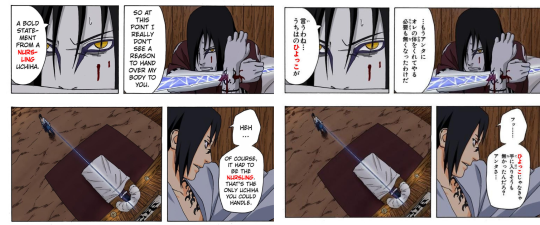

Orochimaru calls Sasuke a "ひよっこ = Hiyoko". ひよっこ which means newbie. ひよっこ derives from the word 「ひよこ」 which means Chick.
Snakes are certainly experts at preying on bird eggs and hatchlings. They can dash into nests, swallow whole eggs, or wrap around the chicks/baby birds and crush them to death. With their elongated body, sharp teeth, striking speed, and venom, birds will have no escape when these slimy predators select them as prey. Some larger snake species have been seen preying on hawks, especially when the birds are nesting or otherwise defenseless on the ground.
Some hawk species are specialized in hunting, catching, killing, and eating snakes. Hawks possess defenses, including sharp talons, strong beaks, keen eyesight, and agile flight maneuvers. Since it has keen eyesight, it can spot a snake from far up in the sky. On seeing a snake, the bird swoops down and catches it with its extremely sharp and powerful talons. While some snakes die upon being attacked with the talons. Then, the hawk will often fly off with the snake to feed on it somewhere else.
In here, Sasuke was a hatchling hawk, so it was easy for Orochimaru to manipulate him. Just like Sasuke says: “If I weren't a baby bird/chick you wouldn't have come near me, right? Itachi was too much for you/impossible for you, so you chose a chick, right? ”

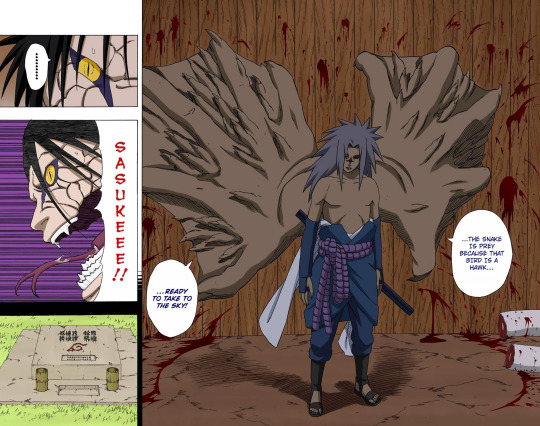
Sasuke (Literal): “A snake squirming on the ground dreaming about flying up into the sky. An impossible dream for you. Regardless of that you went after the chick in the nest, but now you find yourself as the prey. I'm going to soar into the sky...like the eyes of a hawk ”
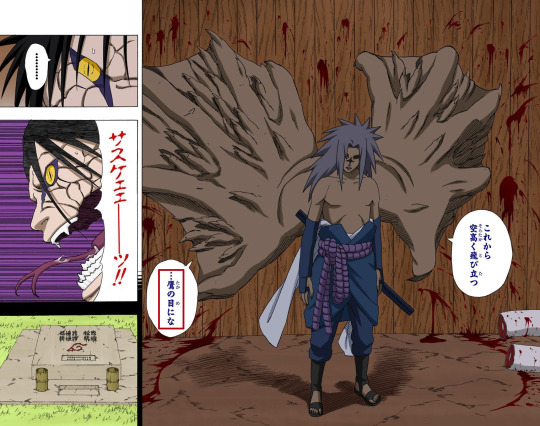
The word usage Sasuke used in here is the Japanese idiom: 鷹の目 ("taka no me"), literally meaning "eyes of a hawk".
This is from Japanese idiom ``Uno-me, Taka-no-me''. This is used as a figure of speech to indicate that ``cormorant'' and ``hawk'' are both ``birds'' that are associated with hunting prey, and ``with a sharp gaze as if aiming for prey.'' This idiomatic expression means : eyes of a predator, keen eyes, eyes of a cormorant, eyes of a hawk.
Birds have extremely good eyesight, and the eyesight of cormorants and hawks, which are able to detect and capture small, fast-moving prey, is many times better than that of humans. when they search for prey, their eyes are full of what is now known as ``powerful eyes/piercing eyes,'' and if the target were to look into those eyes, they would have a chilling effect. They will feel scared.
This proverb is also used to refer to the look in someone's eyes when trying to find faults or weaknesses in someone else. When animals hunt, they generally target the easiest to catch when there is more than one prey. The easiest prey is usually the one that is slow or lagging behind the pack, or the one that has some other disadvantage or weakness. A good hunter, such as a cormorant or hawk, does not miss its prey, but captures it without fail. This is why "the eye of the cormorant and the eye of the hawk" has come to refer to the way they look for rough edges by observing their prey.
Just like how Sasuke waited and observed for his prey's (Orochimaru) weakness and attacked him. Even Oro was surprised "I've never seen such a transformation before", it mean that Sasuke was training for that "transformation (chidori variants)" by himself without telling Orochimaru.
Sasuke was once a baby hawk...who was targeted by a snake. The snake trained him...as he was looking forward to that day when he finally achieve what he wants. But it turned out to be an impossible dream for him…. because now the baby hawk transformed into a matured hawk who targets the snake instead. Hawk soaring high above the sky, using their exceptional vision to spot its potential prey and descending rapidly toward its prey. Here, Snake (Orochimaru) goes from predator to prey when the hawk (Sasuke) flips the script. He's a matured hawk now, one who's capable of defending itself from the "snake".
253 notes
·
View notes
Note
What role/niche do dragons fulfill in their environment? Or, if that is [secret]/redacted/Unknown [by universe parameters], are there other, smaller beasts - creatures not within our world, but common in theirs?

I've been meaning to draw a lot of these for a while now and this was a nice prompt thank you :)
Dragons support a large and surprisingly diverse community of animals. The primary producers are the unique photosynthetic cyanobacteria which are found lining the transparent flotation sacs of cloud fleas. 'Cloud fleas' can refer to any type of airborne zooplankton - that is, animals which do not actively fly but rather drift. Pictured is a daphnia type but there are a few others. The bacteria produce lighter than air gases as a byproduct of photosynthesis as well as nutrients for their hosts. The daphnia type pictured retain their large claws and use them to cling onto other individuals, sometimes producing really large structures which can form fantastic shapes at times. This is how they reproduce also (unlike in the water, they can't just externally fertilise eggs because gravity exists)
When they aggregate in large numbers (swarms reaching billions and billions of individuals), they become easy prey for dragons. The dragons capture the fleas using a dense array of rictal bristles. Living in and among the bristles are the monkey birds, a unique species of flightless bird which act as kleptoparasites, stealing the clumps of fleas bound up in dragon mucous before they can be transported to the dragon's mouth. The bristles are so dense that in order to get in there where the fleas are most concentrated, you wouldn't be able to fly. They spend their lives clinging among the bristles with their feet and wing claws, and they make their nests out of woven strands of mucous. New individuals join the birds' colonies when dragons are mating and their bristles come into contact with one another. Bird populations are controlled by hive serpents, who pick them off for a nice snack.
Barnacles and other filter-feeders are common on the windward-facing side of the dragon (what you'd call the front of the dragon). These do not harm the dragons and offer not much useful food for serpents while being very annoying to eat so they're usually left to their own devices.
The vampire chiton exoparasites can be found basically all over a dragon. They find a piece of cuticle that is thin enough to pierce and drill their siphons down into it to suck the watery connective tissue beneath. They are about a foot long and the main food source for hive serpents.
The serpents themselves are mammals. Nearly every dragon hosts a hive. Despite spending most of their lives on their hosts, they are quite strong fliers; they need to be, in order for the young queens to set out to make their own hives. The 'hive' consists of a reproductive pair and 20-50 of their offspring, with the queen being 1.5x larger than the others and by far the most aggressive. They have one tooth, a single elongated tusk which is used like a crowbar to lever the chitons off the dragon's cuticle. When working on the underside of a dragon, it takes a certain amount of skill to catch the chiton before it falls away. The serpent's neck and legs are very strong to produce enough force to dislodge a chiton, which are often so deeply attached that a human with a pickaxe would struggle to knock one off. The chiton is swallowed whole, and the shell digested.
Serpents viciously defend their dragons, controlling parasite populations and fighting off and attacking humans or large metal creatures they perceive as a threat. The name 'serpent' is given to them in the Mezian theocracy because they are associated with sin; hive serpents can be among the most dangerous combatants a holy beast might face. When the dragon has been killed, its serpents will flee and, more often than not, restart their hive on the ground if they aren't killed first. Outside of the theocracy, humans do raise serpents and use them for various tasks - a baby queen is taken from the wild (by killing every other hive member) and raised to imprint on humans. If their diets are not heavily supplemented with calcium carbonate, they fail to thrive.
#setting: mez#speculative biology#normal birds live up there too but they're not super interesting. they're like swifts or swallows
702 notes
·
View notes
Text
Fish of the Day
Today's fish of the day is the muskellunge!

The muskellunge, also called a musky, lunge, ski, and scientific name Esox masquinongy, is known for being the largest species of pike. Muskellunge can be found around the rivers of Michigan, specifically the Great Lakes region, Canadian waters, St Lawrence River, and around the Mississippi and Ohio river valleys. Outside of their natural range, they can also be found around the Tennessee river, South Carolina rivers, and as far South as Upper Georgia, where they are kept stocked intentionally for recreational fishing. They live around clean and clear waters with little silt, preferring to surround themselves with aquatic vegetation and weeds. This is because they tend to lurk near weedy shores and rocky outcroppings, although they can be found in deeper waters during the summer.

The diet of the muskie is made up primarily of other fish, although they will also eat: frogs, water birds, rats, and other animals that can be found in and around their environments. On rare occasions, muskellunge have been reported attacking dogs and children They attack other animals in an ambush, where the muskie will swiftly bite and swallow, not allowing any time for prey to fight back or escape. They can get as large as 50 inches in length, but there are claims of fish getting as large as 6ft. They have few predators, only large birds, such as bald eagles, other larger muskellunge or pike, and human fishing. With human fish thought to be the cause of their declining numbers.

Similar to other pikes, the muskellunge form small schools, and will claim territories that they fiercely defend, only becoming more aggressive during the breeding season. They spawn in the spring, like other pike, finding clean rocks or sandy bottomed rivers to lay their eggs. Spawning is only around a week to two weeks in length, and eggs are abandoned almost immediately. Once born, juveniles are only a few cm in length, but can get as large as 12 inches by their first year of life, and can get as old as 12-18 years.

That's the muskie fish, have a good day, everyone!
#fish#fish of the day#fishblr#fishposting#aquatic biology#marine biology#freshwater#freshwater fish#animal facts#animal#animals#fishes#informative#education#aquatic#aquatic life#nature#river#ocean#muskellunge
144 notes
·
View notes
Text

Gigan design for a Godzilla au im working on !!
Ramblings about him below cut
OK SO Gigan in this au is a member of a species of Giant bird things called Quetgarons that hunt the M space hunter nebula aliens (but in my au they’re just called the Star Bugs).
The climate Gigan’s specific subspecies lived was a more desert-y climate full of sand. So they were very good at digging since the Star Bugs usually dig their cities underground. Their long beaks and tongues also help to snatch up whatever they can get. Quetgarons are far from picky eaters, they perfer organic food, but they’ll eat whatever they can swallow, and recently have even been seen eating metal. They need whatever nutrition they can to keep their massive (generally 60m+ tall) bodies going. And the appendage on their tail is meant to look like their beaks and is used both to fool prey and to grab things.
With the help of a certain other group of Aliens, the Star Bugs created Gigan by capturing a nearly dead Quetgaron and bringing it back to life using certain modifications. A lot of modifications were added to him, like his entire skeleton being reinforced with metal and other materials due to the gravity on earth being greater than their own planet (and also made him a bit taller for shits and giggles). All parts of him that originally had structures made of cartilage (or the similar material they use) are now also coated in metal to make them resistant to Earth’s weapons since originally, they were weak points. Quetgarons have eyelids that cover most of their eyes in order to avoid sand and other gunk getting into them, but these were removed on Gigan and was given a long red visor to protect his eyes instead.
Before Gigan was sent to Earth, he was purposefully starved for a while in order to make sure he’d fuck up as much stuff as possible on Earth. He is the 40th kaiju this earth has ever documented, followed by 41st being Megalon who popped up shortly after Gigan’s arrival. They fucked a LOT of stuff before Jet Jaguar and Mothra were able to take them both down. Gigan now primarily resides in Earth’s deserts reminiscent of his home, waiting for the day where he can fuck shit up again.
He’s just a funny dude that causes destruction on a mass scale and eats people. We love him for that
#kaiju#art#Godzilla#Godzilla au#Gigan#godzilla vs gigan#speculative biology#<- I think ?? idk#gigan kaiju
59 notes
·
View notes
Text

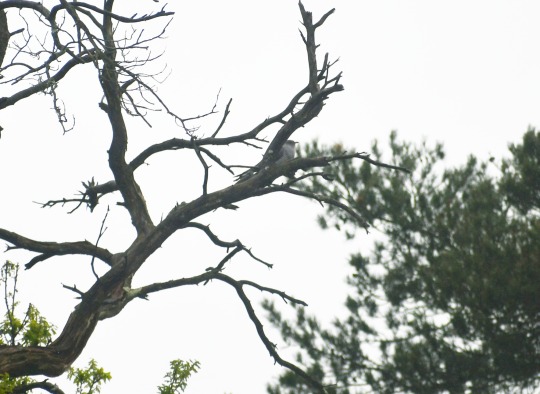

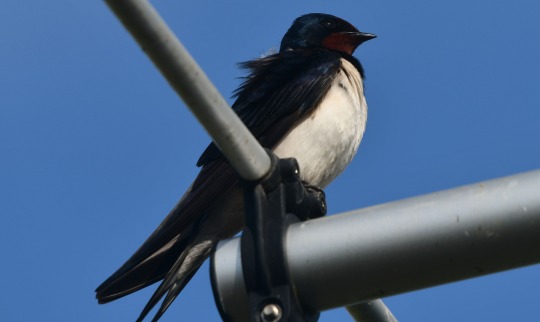
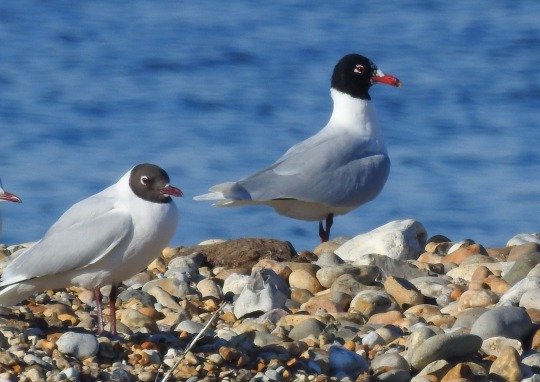


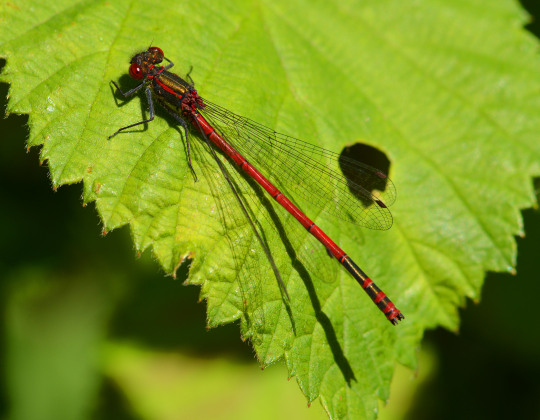

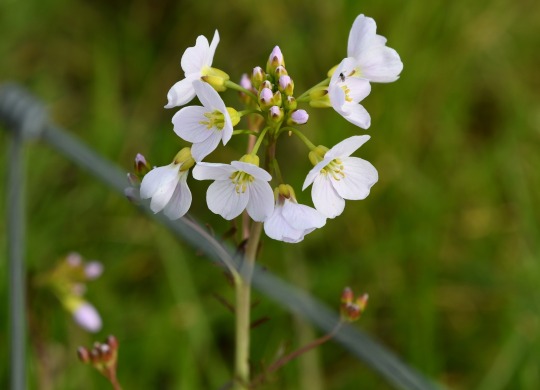
Ten of my favourite spring time sights
In the midst of the Easter weekend, a time for me so intertwined with with the feelings of hope and rebirth that this fine and favourite season of mine brings, I wanted to reflect on some of my favourite sights of this time in nature which together brings one of the greatest shows on earth. There are so many stages of spring for me from the first daffodils tentatively springing up showing the longer days are coming to glorious Marsh Fritillary butterflies stars of the late spring lepidoptera circus, so some in this list are things I've seen already this season, others what is happening right now and some things I look forward to hopefully seeing in the coming weeks. Below is the list in no particular order.
Baby birds
A quintessential sprig time sight, whether it's ducklings and goslings, Great Crested Grebe humbug chicks nestled on parents backs or voracious and noisy young Starlings adorning the garden; seeing young birds brings me immense joy.
2. Cuckoos
Not much epitomises this wonderful season more for me than the consuming echoing call of the Cuckoo and exhilarating views of these enigmatic birds. The adults are with us a short while and those weeks it really feels like the year wakes up.
3. Warblers
Moving on from Cuckoos to a family featuring species who's nests they parasitize, in a similar way to Cuckoos being surrounded by warbler song in reedbeds and other habitats and getting exiting glimpses of pretty birds is a powerful sensory experience. The onomatopoeic Chiffchaffs and the tuneful Blackcaps start the marching band early in the season with migratory Sedge and Reed Warblers with their raspy tones, Whitethroat and exquisite sounding Garden Warbler coming later and the explosive call of the Cetti's Warbler a resident bird now adding to the spring time spectacle.
4. Hirundine and Swifts
Where the warblers rule the reedbeds in spring Swallow, House Martin, Sand Martin and Swift rule the skies. "One Swallow doesn't make a summer" but it lets you know spring has come. There is something of a milestone marker in seeing these species for the first time in a year and knowing hopeful times are here mixed well with wonder when considering the long and arduous journeys these precious species have made to return.
5. Seabirds coming back to nest
A personal favourite of mine with one of the groups of birds that have inspired me most, these favourite birds of mine being here makes it one of the best times of year. Locally for me early on seeing Mediterranean Gulls return to nesting grounds with their pristine jet black heads emerging and their unique wailing call with terns exciting me too are highlights. And further afield I am captivated by the likes of Guillemot, Razorbill, Puffin, Fulmar, Kittiwake and Gannet in immense bustling cliff colonies.
6. Duke of Burgundy butterflies
Butterflies generally are one of my favourite parts of spring, I can't help but be uplifted as a variety of species of these flamboyant insects take to the wing. Duke of Burgundy is one we are lucky to be able to see further afield within our home county of Hampshire and this gem of a butterfly feels a major milestone as often one of the first we go to specifically look for so you know the peak butterfly season is starting to blossom.
7. Orange Tip butterflies
Taking it back and if the season blossoms with the dukes seeing Orange Tips is where it really starts to take root. These bright species light up the world.
8. Damselflies and demoiselles
Dragonflies start coming out in spring but are quite a fixture in the summer and into the autumn too so spring for me feels like the time to focus on the smaller damselflies and demoiselles more, these glowing insects including Common and Azure and Large Red Damselflies and Beautiful and Banded Demoiselles symbolise the wonder and colour this season brings.
9. Snake's-head fritillary flowers
Seeing soggy grassland come alive with these purple and white wonders nodding from their slender stems is a sight that feels my heart with glee in the early days.
10. Cuckooflowers
A caterpillar food plant of the Orange Tip, these pretty flowers seem to emerge with confidence and soon appear in numbers, a part of the natural furniture of those days when you know the season has turned and the bright days of spring are well and truly here.
The photos in this photoset are of; a couple taken yesterday of a Mallard duckling and record shot of a Cuckoo at Cadman's Pool in the New Forest, a Sedge Warbler at Winnall Moors on Wednesday, Swallow at RSPB Bempton Cliffs last June, Mediterranean and Black-headed Gull at Hayling Island Oysterbeds this March, Duke of Burgundy at Noar Hill last year and Orange Tip at Winnall Moors in 2023, Large Red Damselfly at Lakeside Country Park in 2020, snake's-head fritillary at Lakeside recently and cuckooflower there on Monday.
#cuckoo#mallard#sedge warbler#swallow#mediterranean gull#puffin#photography#orange tip#duke of burgundy#seabirds#large red damselfly#snake's-head fritillary#cuckooflower#2025#spring#season#hope#easter#world#england#uk#earth#nature#birdwatching#butterflies#europe#flowers#damselflies#wildlife
19 notes
·
View notes
Text
At it again, from another angle this time.
‘Old’ weapons. Or at least redundant, as a species traverses into space the new technology makes an old gun or even older sword/arrow/spear and so on useless and nearly powerless. The new weapons are ‘ray this’ and ‘beam that’ ‘plasma so and so’ .
Ofcourse this makes sense, the energy based weapons are far less wasteful and lighter, easier to carry and easier to handle. No need to sharpen weapons with a plasma blade and even then, why use close quarters weapons if you have access to stun, kill or poison rays and many more.
On top of that many civilisations prefer to forget their less then stellar past and make analog weapons obsolete. When the humans joined the council many expected them to do the same. They didn’t, production stopped yes, but interested people could still partake in lessons and the old fashioned ways were shown off in museums. Training to be part of a spaceship crew still included lessons in their old weapons as an opportunity to be prepared for going to “newer” worlds.
So with that in mind i have a few little vignettes ideas and for ease’ sake its gonna be on the same ship, the Serpentine.
Important crew:
Primoz, captain -Limoyh a four armed species-
Krag, second in command (brother of Primoz)
Kit, dokter -avian, bird like, she has feathers like a swallow-
Ortez, ASR (all species resources, human resources in space) -kiltak, insectoid species, think ants but exoskeleton-
Lugea, helmsperson (does the steering) -rock like alien-
Artex, engineer/mechanic 1 -also Kiltak-
And then our humans:
Kamari, navigator -Eritrean woman- (has cat named Sidra)
Markus, weapons expert (knows how to use them and upkeep, also shields) -Swedish man-
Petrus, mechanic/engineer 2 -Italian man-
Lilly, administrator/note keeper (learns languages for fun)-english woman-
Yes i know all of this could have also been accomplished by saying they are all from America… nope this is more fun. This is under the assumption that to get into the joint academy for space faring you need to be able to speak and write English.
Obviously there are more people on the ship but these are most important
~~~~~~~~
1. Sparring
Ortez was having a good day, the serpentine had left port and was making good progress toward their next destination on w-kl-18, referred to as deltax by it’s residents, for a routine drop off.
In port on Unity (the planet where the council resides and the universal court is) they picked up the final crew members among who a ‘team’ of humans. Pre bonded humans were supposed to be less chaos inducing and easier bonded with the rest of the crew. Ortez was rather happy the captain listened to him on this matter.
The humans had been more diverse than he expected and were currently what they called ‘settling in’. He was on his way to the rooms they had.
‘Stop it please we’ve been here less than 4 hours!’ The soft voice he recognises as Lilly’s is barely audible over the loud clanging sounds. Rounding the corner Ortez sees a terrifying scene. The two human males locked together with two sticks made of metal baring teeth at each other, with a push the olive skinned man, he remembers is called Petrus, breaks the hold and goes in low swiping at the tall mans legs making Markus fall over.
Ortez is about to intervene when without a sound the dark skinned leader of the group seemingly appears without a sound behind him and runs into the fray with a similar stick.
Whacking Petrus stick away from Markus’ throat she steps inbetween “stop it. You’re scaring our ASR. We want to make a good impression remember.” The men look right at him and both put down the sticks, Markus puts his hand up in a ‘wave’ “sorry about that, Ortez it was right? We were just sparring.’ Moving further into the room he uncurls his front two claws tapping at the metal poles “sparring with this? We usually only do body to body training, this seems rather old.” Petrus speaks up to that “ah yes those are old earth weapons, we like keeping up a bit of skill with several kinds as a side activity. Don’t worry tho, we train with blunt weapons.”
Not entirely appeased the insectoid looks to the imposing woman, who seems entirely at ease even though two people had been fighting. When she caught his eyes, she smiled that terrible toothy grin “truly don’t worry, like Petrus said they are blunt and it is a way for us to let of some steam and keep in shape. But next time we’ll do it in the training rooms… right boys?” Pinning the two men with withering stares they nodded quickly.
Ortez did not know humans released steam, but he felt right now was not the moment to go into that. Saying his goodbye he skittered to inform the captain.
This was bound to be interesting.
~~~~~~~~~~~
2. “The Roman empire”
“So you are telling me that at any given moment you could be thinking about a several thousand years old society that no longer exists and it would surprise nobody?” Artex was perplexed, when he and Petrus were working on the reactor core Lilly had wandered through and mentioned this old civilisation sparking heated debate. She thought the greeks were far more interesting but Petrus had been unmoved by her arguments. The other man speaks while pushing some buttons “well yea, the empire made great strides and amazing structures, Lilly just prefers the mythos of the greek while i enjoy the focus on millitary prowess.” Shrugging he looks up “don’t you guys have something like that?” Artex stretches his legs, all 6 of them in a wave like motion “not really, when change happened the history books were changed to make it seem like it was always that way” the human makes eye contact “wait so how do you know how to play -old civilisation- as a kid? We play fought with wooden sticks, wooden swords and branches we cut to look like guns…” that horrofied the insectoid, raised with violence like it was a normal thing.
Almost like they never left their dark ages
~~~~~~~~~~~~
3. Whats in a name (bit off topic but the idea just kinda happened)
Te very first time the humans were introduced to their new crew there was a bit of a hiccup. When Kamari introduced herself they looked up a bit confused but went further down the row. After Lilly they came back around and referred to Kamari as moon. Now Kamari recognised the strange look, they had translators that only had basic human translation, which means that her name “Kamari” which comes from Arabic and is a word for moon/soft glow of the moon, is translated fully but not as name so when they speak to her it translates out of their language to English which would be moon. This is luckily easily fixed with an update, but it was something that stil spoke of how new the human race was to the cosmos.
Her cat Sidra made them laugh as that means Star so she was the moon with her star.
(Random thought about how multiple human languages could screw with translations)
~~~~~~~~~~~~
Soooooo kinda had a 4th story that is pretty sad but also bad ass, but this is getting too long already
Imma write that in a new post over the coming days
Hopefully people like this, if you have prompts you’d like to see with this crew feel free to ask.
#humans are space orcs#humans in space#humans are space oddities#humans are weird#humans are space australians#humans are insane#humans are deathworlders#humans are space fae#humans are space capybaras
329 notes
·
View notes
Text
Wet Beast Wednesday: leatherback sea turtle
When most people think of big turtles they think of the giant tortoises of the Galapagos. Those may be the biggest land turtles., but in the water, life can get bigger. Much like how whales get bigger than any land mammal, the viscous and buoyant properties of water helping counteract gravity lets sea turtles get bigger than their land counterparts. This Wet Beast Wednesday I'm discussing the largest of all turtles, the mighty leatherback.

(Image: a leatherback sea turtle swimming just below the ocean's surface. It is a very large turtle with ridges running down its shell and its front and hind legs modified into large, paddle-like flippers. It is dark gray all over, with white spots. End ID)
Leatherback sea turtles (Dermochelys coriacea) is not only the largest turtle, it's the heaviest of all living reptiles that aren't crocodilians. Adults average 1.8-2.2 m (6-7.2 ft) in length and 250-700 kg (550-1,540) lbs, with some variation in size based on region. Leatherbacks are the only living members of the family Dermochelyidae while the other 6 living species are all in the family Cheloniidae. This gives leatherbacks multiple anatomical differences from other sea turtles. One of these differences gives the leatherbacks their common names. Instead of a bony shell made of scutes, their shells are made of thick, oily and leathery skin that is embedded with small bony growths called osteoderms. The thick skin and osteoderms provide protection and allow pressure to distribute across the shell, making the shells highly resistant to being bitten trhough and highly resistant to cracking. Seven prominent ridges run down the length of the shell. The shape of the shell makes leatherbacks the most hydrodynamic of all sea turtles. The shell's shape and structure provides it with a high resistance to pressure, useful as leatherbacks dive deeper than any other sea turtle.

(Image: a leatherback sea turtle seen from the front with its mouth open. The head has a beak instead of teeth and the interior of the mouth is fleshy and pink. End ID)
Leatherback sea turtles are powerful swimmers. Their powerful front flipper provide propulsion while the rear flippers are used for steering. The flippers can grow up to 2.7 m (8.9 ft) long, making them the largest of all sea turtles both in overall size and in relation to body size. Those flippers make the leatherback the fastest non-bird reptile, able to reach 35.3 km/h (21.9 mph), though they usually swim much slower. Of all the reptiles to be the fastest, I would never have guessed it would be a turtle. Leatherback beaks are fragile and not suited for biting through anything but soft-bodied animals, so they swallow most of their food whole. The throat is lined with backwards-facing spines that prevent prey from swimming back up the throat. While leatherbacks have scaly hides like other reptiles, they are the only reptile whose scales do not contain the structural protein beta-keratin.

(Image: the mouth of a leatherback being held open to reveal the interior. It is pink and fleshy and lined with backwards-pointing spikes. End ID)
Unlike most (non-bird) reptiles, leatherbacks maintain a core body temperature higher than the surrounding environment. It was formerly believed that this endothermy was established through an increased metabolism, though more recent measurements have establised that leatherbacks do not have a metabolic rate much higher than would be expected for a turtle of their size. It is now thought that body heat is maintained through heavy muscle activity. Leatherbacks are almost always actively swimming and spend at little as 0.1% of their day resting. By constantly swimming, their muscles generate heat. This body heat is then retained through a countercurrent heat exchange system that warms blood before it reaches the core and a thick layer of fat, allowing leatherbacks to inhabit water much colder than any other sea turtle.

(Image: a leatherback sea turtle on the beach, presumably a mother laying eggs. Multiple children are watching it and an adult is roping off the area around it to keep it safe. End ID)
Leatherback sea turtles are found worldwide and have the largest range of any turtle. Thanks to their high body heat, leatherbacks can live in waters as far north as Alaska and as far south as Aotearoa/New Zealand. Scientists have observed three genetically distinct populations, one in the Atlantic ocean and one each in the east and west Pacific Ocean. In addition, there are two other proposed populations, one in the Indian Ocean that is understudied and one in the South China Sea that is nearing extinction. They spend most of their lives in the open ocean, hunting prey. The primary prey of the leatherback sea turtle is jellyfish and they have to eat a lot of them to maintain their size. Other food sources include siphonophores, salps and pyrosomes, small fish, small crustaceans, and seagrass and seaweed. Leatherbacks play an important role in their environments by keeping jellyfish populations under control. Excessive jellyfish can overfeed on the plankton population, removing food sources for small animals and killing larval fish. A lot of jellyfish follow diel vertical migration; moving to deep water during the day and shallow water at night. Leatherbacks are adapted to follow their food and are among the deepest diving of all air-breathing marine animals, having been observed diving over 1,000 m (3281 ft) deep. Only sperm whales and beaked whales are known to dive deeper. Their high body temperature and shell structure allows leatherbacks to survive the frigid temperature and immense pressure of the deep sea. Dives can last up to 70 minutes, though most last from 3 - 8 minutes.

(Image: a leatherback sea turtle underwater, aiming downwards. End ID)
Leatherbacks migrate vast distances between their cold feeding grounds and the warm, tropical waters where they mate. Females may release pheromones into the water to attract males. Once a male find a female, he will attempt to woo her through head and flipper movements, nuzzling, and biting. When the female accepts, the two mate while in the water and then depart. Females must haul out of the water and onto shore to lay their eggs. Like other sea turtles, they tend to return to the beach of their birth, though they may also choose nearby beaches. Their preferred beaches have soft sand and a low angle of entry that face deep water. They also prefer beaches that have forests or dunes on the edge. Females lay eggs at night to avoid predators and overheating, but they have poor night vision. Thus, they prefer the forests and dunes to give a clear distinction between the moonlit ocean and the darkness at the edge of the beach. That way they can find they way onto shore by following the shadows and back to sea by following the light. Eggs must be laid above the high tide line and are buried in the sand. Females will mate multiple times each mating season and can lay a new clutch of eggs for each mating. An average clutch has 110 eggs, half of which will hatch. Eggs hatch in 60-70 days and the temperature of the sand around them determines whether the young will develop into males or females. In addition, eggs laid in colder sand usually develop into larger and more robust juveniles. Eggs hatch in groups during night and the hatchlings will follow moonlight reflected off of the water to find the ocean. During the trip to the water, many hatchlings will be lost to predation by opportunistic land predators and seabirds. Those who reach the water have a chance at survival, but are still preyed upon by squid, large fish, and sharks. Only a very few hatchlings will live long enough to reach adulthood.

(Image: a leatherback laying eggs. She has dug out a pit behind her and is releasing small, spherical, white eggs into it. End ID)
Leatherback sea turtles are classified as vulnerable to extinction by the IUCN, with some populations being more endangered than others. In particular, the east Pacific, west Pacific, southwest Indian, and southwest Atlantic subpopulations are listed as critically endangered, with the rest being either endangered or data deficient. Human activity is a major threat to the turtles. Leatherbacks can be caught as bycatch in nets or lines, leading to drowning and they are too large for some turtle safety mechanisms (like escape hatches on nets) to work. Pollution is also a major problem as floating plastic bags can be mistaken for jellyfish and swallowed. These bags can then obstruct the digestive system, ultimately killing the turtle. Another major problem is light pollution. Because hatchlings follow the brightest lights to reach the ocean, they can end up following artificial light instead of moonlight and end up moving away from the ocean instead of toward it. While adults are rarely caught for food, eggs are heavily harvested in southeast Asia and the Caribbean, where they are seen as delicacies or medicinal. It has been suggested that the population collapse in the South China Sea is largely due to overharvesting eggs for use in cuisine. Multiple countries around the world have given the turtles legal protection and local government and private agencies are aiding in turtle conservation through methods like helping juveniles reach the sea, artificial incubation of eggs, and raising awareness through ecotourism.

(Image: a hatchling leatherback. It is a miniature version of an adult and is climbing over other eggs, many of which are in the process of hatching. End ID)
#wet beast wednesday#leatherback sea turtle#sea turtle#reptile#turtles#turtle#marine biology#biology#ecology#zoology#marine life#marine reptile#educational#informative#animal facts#image described#absolute unit
78 notes
·
View notes